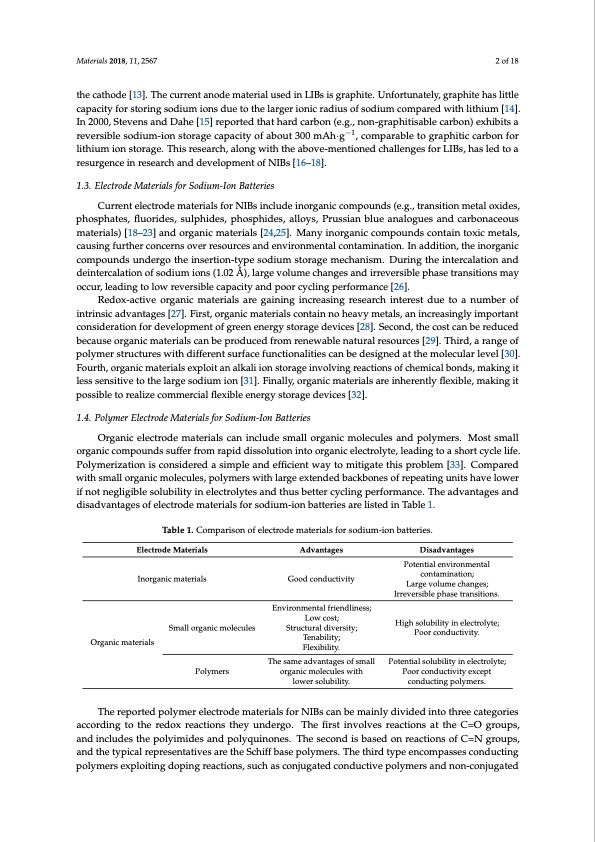
PDF Publication Title:
Text from PDF Page: 002
Materials 2018, 11, 2567 2 of 18 the cathode [13]. The current anode material used in LIBs is graphite. Unfortunately, graphite has little capacity for storing sodium ions due to the larger ionic radius of sodium compared with lithium [14]. In 2000, Stevens and Dahe [15] reported that hard carbon (e.g., non-graphitisable carbon) exhibits a reversible sodium-ion storage capacity of about 300 mAh·g−1, comparable to graphitic carbon for lithium ion storage. This research, along with the above-mentioned challenges for LIBs, has led to a resurgence in research and development of NIBs [16–18]. 1.3. Electrode Materials for Sodium-Ion Batteries Current electrode materials for NIBs include inorganic compounds (e.g., transition metal oxides, phosphates, fluorides, sulphides, phosphides, alloys, Prussian blue analogues and carbonaceous materials) [18–23] and organic materials [24,25]. Many inorganic compounds contain toxic metals, causing further concerns over resources and environmental contamination. In addition, the inorganic compounds undergo the insertion-type sodium storage mechanism. During the intercalation and deintercalation of sodium ions (1.02 Å), large volume changes and irreversible phase transitions may occur, leading to low reversible capacity and poor cycling performance [26]. Redox-active organic materials are gaining increasing research interest due to a number of intrinsic advantages [27]. First, organic materials contain no heavy metals, an increasingly important consideration for development of green energy storage devices [28]. Second, the cost can be reduced because organic materials can be produced from renewable natural resources [29]. Third, a range of polymer structures with different surface functionalities can be designed at the molecular level [30]. Fourth, organic materials exploit an alkali ion storage involving reactions of chemical bonds, making it less sensitive to the large sodium ion [31]. Finally, organic materials are inherently flexible, making it possible to realize commercial flexible energy storage devices [32]. 1.4. Polymer Electrode Materials for Sodium-Ion Batteries Organic electrode materials can include small organic molecules and polymers. Most small organic compounds suffer from rapid dissolution into organic electrolyte, leading to a short cycle life. Polymerization is considered a simple and efficient way to mitigate this problem [33]. Compared with small organic molecules, polymers with large extended backbones of repeating units have lower if not negligible solubility in electrolytes and thus better cycling performance. The advantages and disadvantages of electrode materials for sodium-ion batteries are listed in Table 1. Table 1. Comparison of electrode materials for sodium-ion batteries. Electrode Materials Inorganic materials Advantages Good conductivity Environmental friendliness; Low cost; Structural diversity; Tenability; Flexibility. The same advantages of small organic molecules with lower solubility. Disadvantages Potential environmental contamination; Large volume changes; Irreversible phase transitions. High solubility in electrolyte; Poor conductivity. Potential solubility in electrolyte; Poor conductivity except conducting polymers. Organic materials Small organic molecules Polymers The reported polymer electrode materials for NIBs can be mainly divided into three categories according to the redox reactions they undergo. The first involves reactions at the C=O groups, and includes the polyimides and polyquinones. The second is based on reactions of C=N groups, and the typical representatives are the Schiff base polymers. The third type encompasses conducting polymers exploiting doping reactions, such as conjugated conductive polymers and non-conjugatedPDF Image | Polymer Electrode Materials for Sodium-ion Batteries

PDF Search Title:
Polymer Electrode Materials for Sodium-ion BatteriesOriginal File Name Searched:
materials-11-02567.pdfDIY PDF Search: Google It | Yahoo | Bing
Salgenx Redox Flow Battery Technology: Salt water flow battery technology with low cost and great energy density that can be used for power storage and thermal storage. Let us de-risk your production using our license. Our aqueous flow battery is less cost than Tesla Megapack and available faster. Redox flow battery. No membrane needed like with Vanadium, or Bromine. Salgenx flow battery
| CONTACT TEL: 608-238-6001 Email: greg@salgenx.com | RSS | AMP |